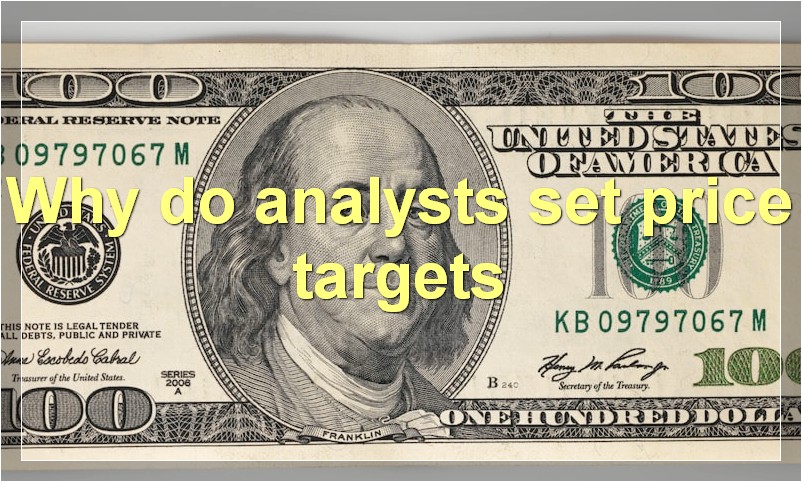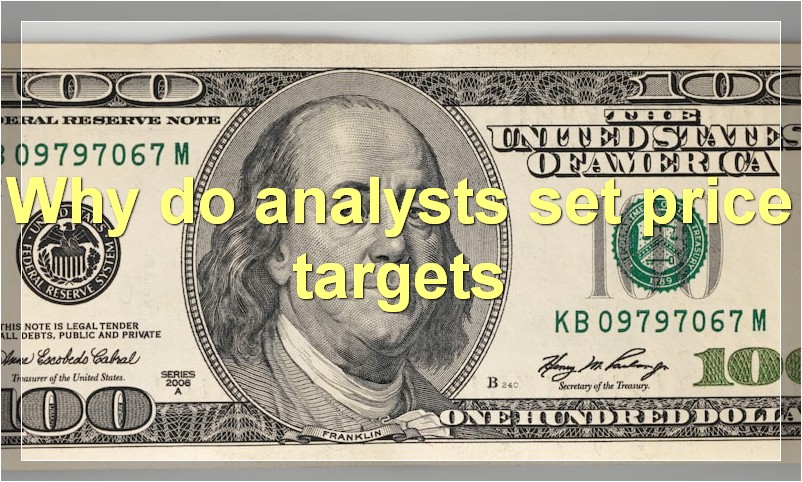If you’re an investor, you know that price targets are important. But what do you really know about them? In this article, we’ll take a look at the good, the bad, and the ugly of price targets.
What is a price target
A price target is the projected price level of a financial security, as stated by an investment analyst or financial institution. Price targets are used by investors and analysts as benchmarks to gauge whether a security is undervalued or overvalued.
When an analyst provides a price target, it is generally accompanied by a rating that indicates whether the target is buy, hold, or sell. For example, if an analyst has a buy rating on a stock with a $30 price target, the analyst believes the stock will appreciate and is recommending that investors buy the stock. If the stock reaches the analyst’s $30 price target, the analyst would likely issue a new rating and price target.
Why do analysts set price targets

Analysts set price targets because they believe that a stock will reach a certain price within a certain time frame. They use their knowledge of the company, its financials, and the market to come up with a target price.
Investors often use price targets set by analysts as a guide when making investment decisions. Analysts’ price targets are not always accurate, but they can give you an idea of where a stock is headed.
How are price targets determined
There is no one-size-fits-all answer to this question, as the determination of price targets is a highly individualized process that depends on a number of factors. However, there are some general considerations that typically go into setting price targets.
One important factor is the current market conditions. If the market is currently undervalued, then a higher price target may be appropriate in order to reflect the true value of the security. Conversely, if the market is overvalued, then a lower price target may be more realistic.
Another key consideration is the company’s financial situation. This includes factors such as its earnings history, debt levels, and cash flow. Based on this information, analysts can develop a model to estimate what the company is worth and set a price target accordingly.
Finally, it is also important to consider the opinions of other analysts when setting a price target. While it is ultimately up to the individual analyst to determine his or her own target price, it can be helpful to see what others in the field are saying. This can give a sense of where the consensus is and whether the target price is achievable.
Do price targets always reflect the true value of a stock
When it comes to stocks, there is no definite answer as to whether or not price targets always reflect the true value of a stock. While some investors might use price targets as a guide to help them make investment decisions, others might view them as nothing more than an estimate or prediction. In the end, it really depends on the individual investor and how they choose to interpret price targets.
Do all analysts have the same price target for a particular stock
No, analysts do not have the same price target for a particular stock. Each analyst has their own opinion on where they believe the stock will go in the future. This is based on a number of factors, including their own research and analysis.
Can a company’s stock price exceed its price target

It is not uncommon for a company’s stock price to exceed its price target. In fact, it happens quite often. There are a number of reasons why this might happen.
First, a company’s stock price is based on the company’s current earnings and future prospects. If a company’s earnings are better than expected, then its stock price will likely go up. Similarly, if a company’s future prospects look good, then its stock price will also go up.
Second, a company’s stock price is also affected by the overall market conditions. If the stock market is doing well, then most stocks will go up in value, including the stock of the company in question.
Third, there may be specific news about the company that causes its stock price to go up. For example, if the company announces a new product or partnership, this may cause investors to buy the stock, driving up the price.
Ultimately, there are many factors that can cause a company’s stock price to exceed its price target. While it may seem like a rare occurrence, it is actually quite common.
What happens if a company misses its price target
If a company misses its price target, it could mean that the company’s products are not selling as well as expected. This could lead to the company losing money and potentially going out of business.
Is there any downside to setting a price target
There are a few potential downsides to setting a price target. The first is that it may be difficult to achieve the target if market conditions are not ideal. This can lead to frustration and discouragement. Second, setting a high price target may cause an investor to miss out on opportunities to buy shares at a lower price. Finally, if the stock price does not reach the target, it may give the false impression that the company is not doing well.
Are there any benefits to setting a price target
A price target is the price at which a security is expected to trade in the future. Price targets are used by investors and analysts to determine whether a stock is undervalued or overvalued.
There are several benefits to setting a price target. First, it provides a goal for investors to strive for. Second, it can help investors discipline their buying and selling decisions. Finally, it can help investors track their progress over time.
Does a company’s share price always follow its price target
A company’s share price does not always follow its price target. Sometimes a company’s share price will be above its price target, and sometimes it will be below.

